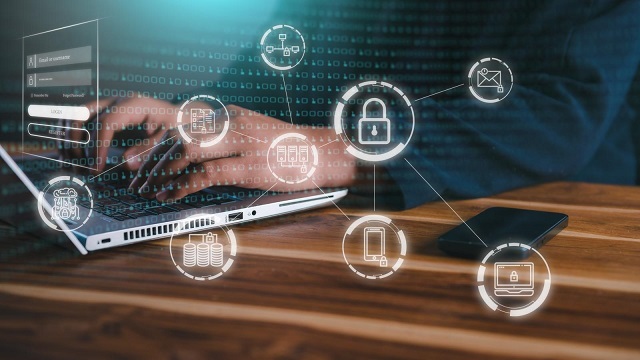Cybersecurity: Protecting Your Digital Life
Understanding the Modern Cyber Threat Landscape
As our lives become increasingly digital, the need for robust cybersecurity practices has never been more critical. Cyber threats today are more sophisticated and varied, targeting individuals, businesses, and governments alike.
The digital world, once a domain of convenience, is now a battlefield where protecting your data and privacy is paramount. Cybersecurity is no longer optional; it's a necessity.
Key Threats in the Digital Age
- Malware: Malicious software designed to disrupt, damage, or gain unauthorized access to systems.
- Phishing: Fraudulent attempts to obtain sensitive information by disguising as a trustworthy entity.
- Ransomware: A type of malware that encrypts the victim's data, demanding payment for the decryption key.
- Social Engineering: Psychological manipulation of people into performing actions or divulging confidential information.
These threats can have devastating effects, from financial loss to identity theft. Therefore, understanding the landscape is the first step in safeguarding your digital life.
Implementing Strong Cybersecurity Practices
To protect your digital life, implementing strong cybersecurity practices is essential. These practices are not only about using the right tools but also about cultivating the right habits.
Password Security:
- Use Strong, Unique Passwords: A strong password is a combination of letters, numbers, and symbols. Avoid using easily guessable information such as birthdays or common words.
- Enable Two-Factor Authentication (2FA): 2FA adds an additional layer of security by requiring a second form of identification, such as a code sent to your phone.
Software Updates:
- Regularly Update Software: Keeping your software up-to-date ensures that you have the latest security patches. Cybercriminals often exploit vulnerabilities in outdated software.
- Automate Updates: Whenever possible, set your devices to automatically install updates to minimize the risk of missing critical patches.
Secure Your Devices:
- Install Antivirus Software: Reliable antivirus software can detect and neutralize threats before they cause harm.
- Use a VPN: A Virtual Private Network (VPN) encrypts your internet connection, making it more difficult for hackers to intercept your data, especially on public Wi-Fi networks.
By adopting these practices, you significantly reduce the risk of falling victim to cyberattacks. Remember, cybersecurity is a continuous process that requires vigilance and regular updates to your security measures.
Protecting Your Personal Data and Privacy
 In an age where data is the new currency, protecting your personal information is crucial. Cybercriminals are constantly devising new ways to steal and exploit data, making it imperative to safeguard your privacy both online and offline.
In an age where data is the new currency, protecting your personal information is crucial. Cybercriminals are constantly devising new ways to steal and exploit data, making it imperative to safeguard your privacy both online and offline.
Data Encryption:
- Encrypt Sensitive Data: Encryption is the process of converting information into a code to prevent unauthorized access. Use encryption tools to protect your sensitive files and communications.
- Secure Cloud Storage: If you store data in the cloud, ensure it’s encrypted, and use services that offer robust security features.
Be Wary of Social Media:
- Limit Personal Information: Avoid sharing too much personal information on social media platforms. Cybercriminals can use this information for identity theft or phishing attacks.
- Review Privacy Settings: Regularly review and update your privacy settings to control who can see your information.
Identity Protection:
- Monitor Your Accounts: Regularly monitor your financial accounts for any suspicious activity. Consider using identity theft protection services for added security.
- Be Cautious with Emails: Phishing emails often appear legitimate but are designed to steal your personal information. Be cautious with unsolicited emails and avoid clicking on unknown links.
By taking these steps, you can protect your personal data and maintain your privacy in an increasingly connected world.
Preparing for the Future of Cybersecurity
As technology evolves, so do the methods employed by cybercriminals. Preparing for the future of cybersecurity involves staying informed about emerging threats and adapting your strategies accordingly.
Stay Informed:
- Follow Cybersecurity News: Keep up-to-date with the latest cybersecurity news and trends. Understanding new threats and vulnerabilities will help you stay ahead of potential risks.
- Educate Yourself: Consider taking online courses or attending seminars to deepen your understanding of cybersecurity. Knowledge is one of the most powerful tools in combating cyber threats.
Adopt Advanced Technologies:
- AI and Machine Learning: These technologies are being increasingly used to detect and respond to cyber threats in real-time. Consider adopting solutions that leverage AI for enhanced protection.
- Blockchain: Blockchain technology offers a new level of security by decentralizing data storage and ensuring transparency. It’s a technology worth exploring for future-proofing your digital life.
Plan for Incidents:
- Create a Cybersecurity Response Plan: In the event of a breach, having a response plan can minimize damage and speed up recovery. This plan should include steps for identifying, containing, and eradicating threats, as well as restoring affected systems.
- Back Up Your Data: Regularly back up your important data to prevent loss in case of a cyber incident. Ensure that your backups are stored securely and are easily accessible in an emergency.
By preparing for future challenges, you can enhance your cybersecurity posture and protect your digital life in the long term.
References
- National Institute of Standards and Technology (NIST) - Cybersecurity Framework
- Cybersecurity & Infrastructure Security Agency (CISA) - Protecting Your Digital Life
- Norton - Common Cybersecurity Threats
- Cybersecurity and Privacy - Encryption Basics
- Kaspersky - The Importance of Software Updates
- McAfee - The Role of Antivirus Software in Cybersecurity
- Harvard Business Review - The Future of Cybersecurity
- Forbes - The Role of AI in Cybersecurity
- Identity Theft Resource Center - Protecting Your Identity Online
- Federal Trade Commission - Phishing Scams


































